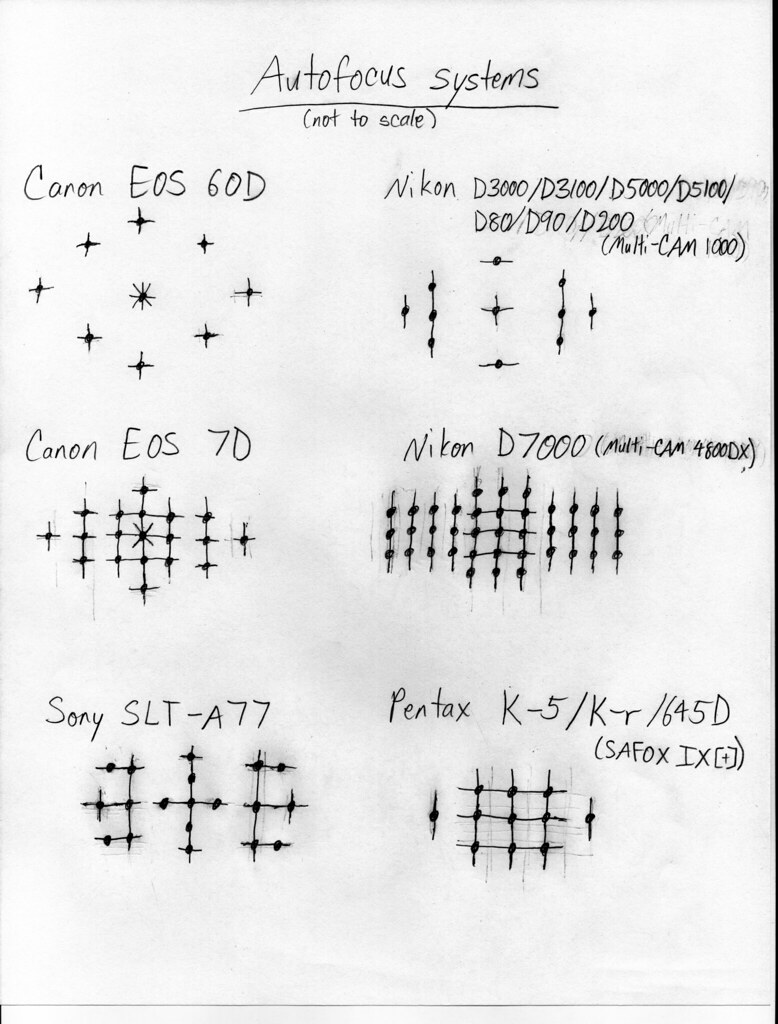I've posted a diagram of autofocus systems from various manufacturers. Though it's not very neat, it states how the points in autofocus systems are typically arranged, to the best of my knowledge. I may not be correct on all points, though, so let me know if there are any errors.

Points indicated by a vertical line are sensitive to horizontal contrast, while points indicated by a horizontal line are sensitive to vertical contrast. Cross-type points are indicated by an intersection of both horizontal and vertical lines. Points indicated by horizontal, vertical, and diagonal lines are high-precision dual cross-type that are sensitive to diagonal contrast with lenses of at least f/2.8. For more information, see
this Cambridge in Colour tutorial.
As you can see, the autofocus points are often arranged in groups. However, I know from experience that Canon and Nikon AF systems can indicate that one, many, or all points are in focus at the time the AF system is activated, regardless of whether these points are directly connected to each other as in the diagram. (I'm not sure about Sony, though.)
Compared to Canon and Nikon, there are several vital limitations with the Pentax AF system that hamstring its ability to cope with fast action. The most critical limitation is that
no more than two adjacent points will activate at any given time, and the linear horizontal-sensitive points at the sides will not work together with any of the cross-type points. This has several important consequences that
hinder the implementation of a reliable predictive focus tracking system:
- It cannot use a large group of points simultaneously to track a moving subject, greatly reducing its ability to maintain a lock on a fast-moving subject or predict its position.
- The camera will not use the outer points of the AF array unless there is nothing to focus on in the center of the frame, even when the camera is set to select from all 11 points.
- Because it isn't considering the objects around the active AF point(s), the AF system is not capable of accurately distinguishing between the intended subject and any obstructions, making it prone to inappropriately refocusing when such an obstruction appears in front of the subject.
- Two points is often not enough to cover the entire subject. This can make it impossible to keep track of the entirety of a moving subject, making it vulnerable to losing track of a fast-moving subject moving across the frame or directly toward the camera.
Furthermore,
Pentax AF points are much larger than that of competing cameras, since the nine cross-type points cover a fairly large area of the frame and are directly connected to each other. (For comparison, Olympus, though not shown in the diagram, uses a similar layout in the E-3 and E-5, but with all points dual cross-type in a shape similar to that of a number sign [#], and the points are not connected together.) Points this large simply can't be arranged with sufficient density to form an
area AF system such as that of the Nikon D7000. As such,
there are too few points in the AF system, making it significantly more difficult to keep track of a fast-moving subject.
My analysis is intended to explain why Pentax AF is widely believed to be inferior to C&N systems. Keep in mind, though, that I'm not trying to bash Pentax AF, but to help Pentax make it better. The current SAFOX IX system is quite fast for static subjects in both outdoor and indoor environments. Given the limitations listed above, here's what Pentax can do to improve AF performance with moving subjects:
- Allow any number of AF points to work together, even if they are not connected to each other. This is the single most important thing Pentax can do to improve AF performance. It requires treating each point as a separate entity, yet allowing them to be used simultaneously in an arbitrary arrangement. Doing so eliminates many of the issues and limitations listed above and paves the way for much more advanced predictive tracking algorithms to be implemented. It may be possible to implement this for current cameras via a firmware update, but hardware limitations may prevent this from happening.
- Shrink the AF points and arrange more of them in a dense grid. Smaller AF points can more precisely and predictably focus on smaller subjects or parts or subjects. More importantly, though, they can be arranged together in large, dense groups to form an area AF system as mentioned above. The result is a array of points, each with subject-to-camera distance information, which can be used to predict the position of the subject more accurately. This can also improve AF performance with static subjects. Even if an area AF system is not implemented, relatively few points covering a large segment of the frame should not be connected together as they are in the current design, as this will require that the points be larger than they should be.
- Develop better predictive AF tracking algorithms. Improvements in AF hardware are not sufficient. Without better software algorithms, the AF tracking performance will not be much better than the existing system.
I hope Pentax takes these suggestions seriously so that we can see a much better AF system in the next generation of cameras, so that it can meet the rigors of sports photography as well as other fast-action photography. This will make Pentax much more attractive to professional photographers than it currently is.
Moderators: Consider making this thread sticky so it can get more attention from the community as well as Pentax itself. These are important suggestions to Pentax that can have a substantial impact on AF performance in future cameras.
--DragonLord
Last edited by bwDraco; 04-09-2012 at 07:44 AM.


 Similar Threads
Similar Threads 





















